

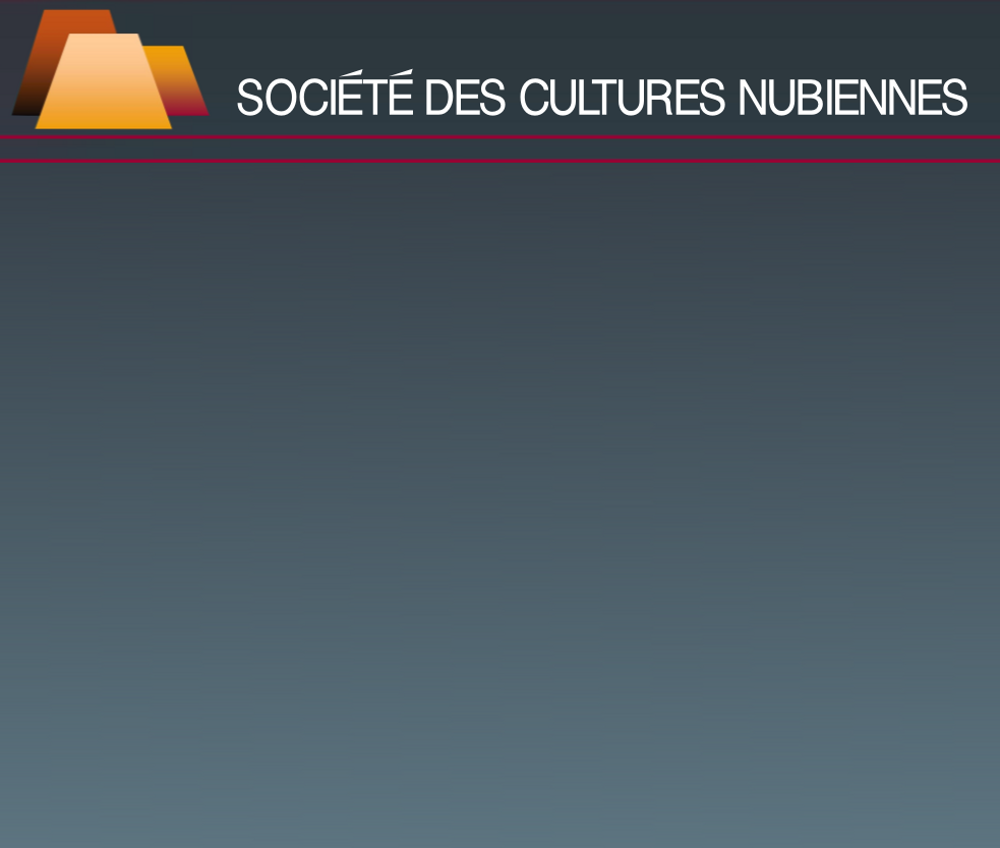
| FIRST GROUP : The temple of Amada, the speos-temple of Derr, the grave of Pennut (west bank)
The Temple of Amada This building is moved in December of 1964, to 2.5 km from its original location and 65m higher up. The rear part, weighing about 900 tons, is transported as one unit. This prowess is realised by a French team under the direction of Jean Trouvelot, architect, Inspector general of Historical Monuments, and head of the operation between 1964 and 1965. The delicacy of the decoration, stuccoed and painted, could not withstand being taken apart. The holy of holies is separated from the vestibule, also known as the pronaos (22m deep and 9m wide), surrounded by a protective coating of concrete and placed on carts. Thanks to a hydraulic system (jacks allowing for permanent flotation), it is moved on three railroad tracks to its current location.
The rescue was difficult, Amada is far from everywhere. An exceptional flood made it necessary to build a dyke. The irregular terrain does not make the laying of 150m of rail track easy. The summer heat dries out the concrete too fast. The move takes three months. At the new site, the temple is placed with its original orientation.
The building, consecrated to Amun and Re-Horakhty, was built under Thutmose III and his son, Amenhotep II (sanctuary and vestibule). Thutmose IV erected the hypostyle hall and Seti I the pylon. The latter and his son, Ramses II, added some of decoration as well as restoration work. The hypostyle hall, made up of proto-Doric grooved columns, attracted the attention of Jean-François Champollion when he visited Amada on the 18th of January 1829: '... they are clearly the type Greek Doric column; and because of an unusual circumstance that must be remarked on, I only find them used in the older Egyptian monuments...'
The sanctuary contains two major inscriptions. The most ancient, from the third year of the reign of Amenhotep II, is a stela set into the rear wall (to the east). The text mentions the work carried out under Thutmose III and describes a victorious war in Asia of Amenhotep II: 'His Majesty returned full of joy to his father Amun after having killed with his own mace the seven chiefs that were in the district of Takhesy, chiefs that were then hung from the prow of the ship of His Majesty'. The other, on the left or north side, speaks of the defeat of Libyans that had attempted to invade Egypt during the fourth year of the reign of Merenphtah, the fourteenth son of Ramses II.
The reliefs of the left chapel describe the ceremonies of the foundation and the consecration of the temple by Thutmose III and Amenhotep II. Those of the right hand chapel show scenes of offerings. |
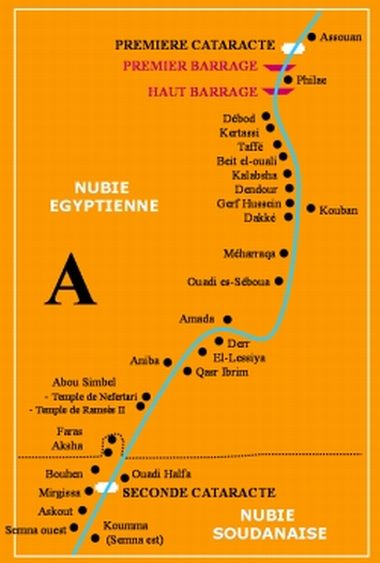 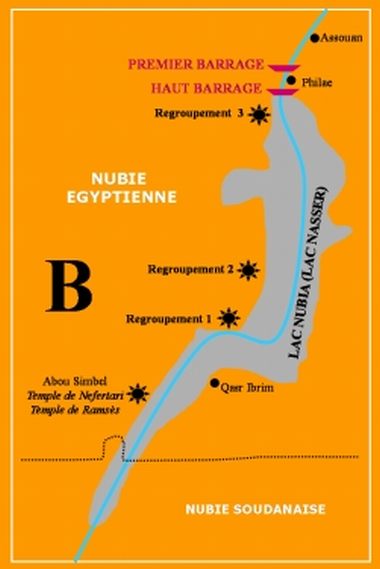 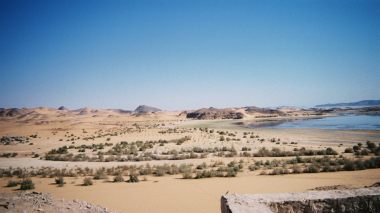 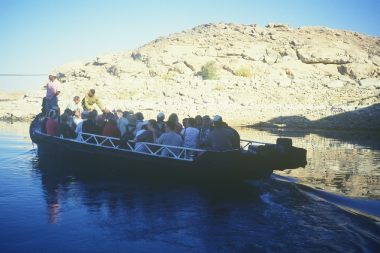 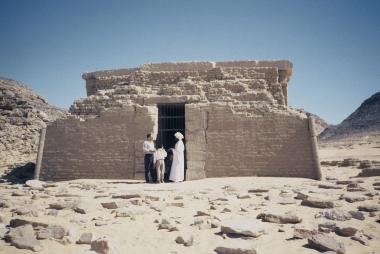 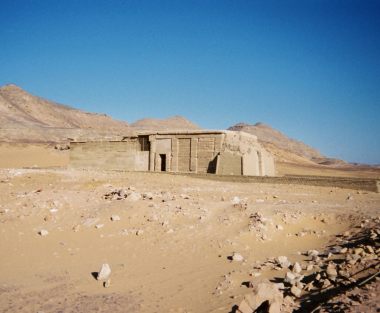 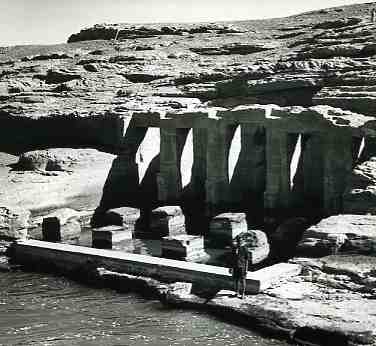 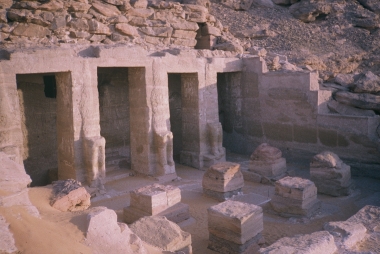  Temples and fortresses along the Nile valley before the building of the High Dam of Assouan / Temples et forteresses de la vallée du Nil avant la mise en eau du Haut-Barrage d'Assouan
Gathering of the temples of the Nile valley after the buiding of the High Dam of Assouan / Regroupement des temples de la vallée du Nil après la mise en eau du Haut-Barrage d'Assouan
Shore of the Nubia lake (Nasser lake) / Rivage du lac Nubia (Lac Nasser)
Coming alongside the Nubia lake (Nasser lake) / Accostage sur le rivage du lac Nubia (Lac Nasser)
Amada temple situated on the western shore of the Nile and built mainly under the king of Thotmes III / Temple d'
Amada situé sur la rive occidentale du Nil et construit principalement sous le roi Thotmès III
Amada temple situated on the western shore of the Nile and moved up over rails (French mission directed by Jean Trouvelot) / Temple d' Amada situé sur la rive occidentale du Nil et déplacé sur des rails pour être repositionné 60 mètres plus haut (Mission Française dirigée par Jean Trouvelot )
The Derr temple was situated on the eastern side of the Nile, facing Amada before its reconstruction on the western side. The temple has been built under the king Ramses II and is dedicated to Ra-Horakhty (Photo Unesco/Paul Amasy 1960) / Le temple de Derr était situé à l'origine sur la rive orientale du Nil, en face d'Amada. L'hémi-spéos a été reconstruit sur la rive occidentale dans le second regroupement. Le temple édifié sous Ramsès II est dédié à Ra-Horakhty (Photo Unesco/Paul Almasy 1960)
Today, the Derr temple situated on the western side of the Nile. The temple has
been built under the king Ramses II and dedicated to Ra-Horakhty / Aujourd'hui, le temple de Derr situé sur la rive occidentale du Nil. Le
temple édifié sous Ramsès II est dédié à Ra-Horakhty
The entrance of the grave of Pennout. He was the vice-king of Nubia under Ramses VI / L'entrée de la tombe rupestre de Pennout. Il était le vice-roi de Nubie sous Ramsès VI
|
|
We give Champollion the honour of concluding: 'the sculpture of the temple belongs to the belle époque of Egyptian art and is preferable to that of Derri (Derr) and even to the religious tableaux of Ibsambu (Abu Simbel)'.
The speos-temple of Derr (originally on the east bank)
Champollion discovered the remains of the temple on the 17th of January 1828: 'we were at Derri, the current capital of Nubia, where we supped, having arrived by an admirable moonlight, and under the highest palm-trees that we had yet seen... there I found a list, rank by rank according to age of the sons and daughters of 'Sesostris' (Ramses II) that will allow me to complete that of Ibsamboul.... It is there that I was able to fix my opinion on a strange fact, I mean the lion that in the tableaux of Ibsamboul and Derri always accompanies the Egyptian conqueror. What we do not know is whether this animal was placed there symbolically to express the valour and the force of Sesostris, or if this king really had, like the pasha of Egypt a trained lion, his faithful companion on his military expeditions. Derri decides the question. I have read, in fact, above the lion throwing itself over the Barbarians overthrown by Sesostris, the following inscription: 'the lion, Servant of His Majesty, cutting his enemies into pieces'.
There only remain some osiriac pillars in the first room of the hemi-speos. On the other hand the hypostyle presents some very beautiful polychrome reliefs: - a scene represents a campaign of Ramses II in Nubia - on the rear wall, the king brandishes his mace hedj about to sacrifice a group of captives while his famous lion attacks other Nubians - Ramses II processes, both as great priest and as an already deified sovereign
The vestibule, a type of hypostyle hall, contains ritual scenes of the divine cult. As for the sanctuary, one notes the representation of divine barks with at the rear, the great gods flanked by Ramses. It is probable that this temple-speos, dedicated to the solar form of the king, was erected for the celebration of his first jubilee. In the first room, a relief depicts Ramses receiving the jubiliary sign Heb-Sed from the gods Nefertum and Amun-Re. In 1965 Egypt disassembles this last monument still in situ. The workmen cut the blocks of the building into sections to place them near that of Amada.
The funerary chapel of the viceroy of Nubia, Pennut 'Royal son of Kush' under Ramses VI (XX Dynasty), Pennut is buried at Aniba, on the west bank opposite Qasr Ibrim.His tomb is made up of only one room. To the right, the reliefs describe the life of the viceroy with a donation of land for the cult of the royal statues. The text mentions that Pennut has re-conquered territories from the peoples to the South. To the left, the 'royal son' and his wife present themselves in an attitude of prayer. One observes funerary scenes. The niche in the rear wall held three statues in poor condition. On each side of this niche, the scenes of adoration show the deceased, his wife and children in front of different divinities. The tomb of Pennut was moved out of the reach of the waters in 1964 thanks to a donation from the United States, but the work of rebuilding was under Egyptian direction. Aniba or Miam, is capital of Lower Nubia during the New Kingdom. The archaeological excavations of Reisner and Firth (1907-1911) give us important information on the general history of Nubia through the study of 151 cemeteries and 8000 graves.
Graves of Nubian princes (Djehuti-hotep and Amenemhat), built at the time of the Egyptian occupation, date to the reigns of the queen Hatchepsut and of Thutmose III. On the other hand, that of Heqanefer dates to the reign of Tutankhamun, but he is also present in the Theban grave of Huy, viceroy of Nubia at the end of the XVIII Dynasty. In fact, the titles of these princes show that they were educated at Thebes, at the court of the sovereign in the company of the royal princes, in an institution called, 'the children of the Kap'. They were brought up according to the rules of the Egyptian administration, then sent to their home country as governors.
|
|